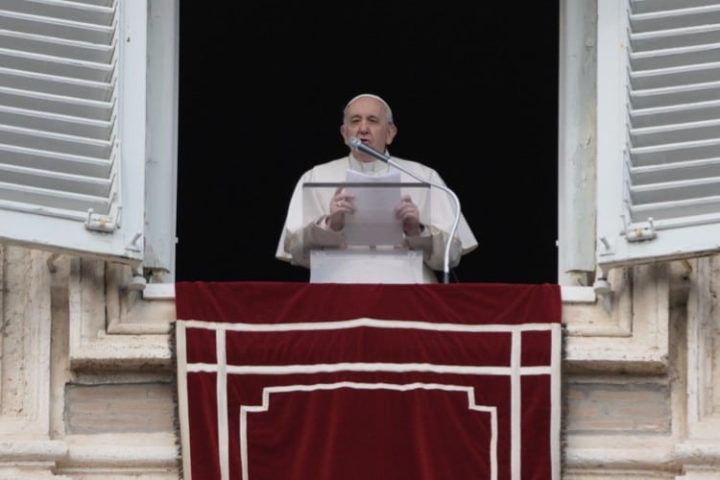
Editor’s note: The same day last week that Pope Francis allowed an abortion cheerleader, United States House Speaker Nancy Pelosi (D-Calif.), to receive Holy Communion at the Vatican — despite an explicit injunction from the archbishop of her home diocese in San Francisco — the pope also published an open letter to all Catholics. In it he discusses “the liturgical formation of the people of God.” Liturgy is a word that refers to how people worship publicly.
The letter is a follow-up to a document he issued to Catholic bishops in July 2021. Entitled Traditionis custodes (“Guardians of Tradition”), last year’s text dealt with an administrative matter in the Church — a planned demolition of the traditional rite of Catholic Mass that existed prior to liturgical changes implemented in the late 1960s. Traditionalist Catholics refer to it as the “Tridentine Rite,” whereas mainstream Catholics call it the “Extraordinary Form” of Mass.
In this latest missive, the pope reaffirms his intent to consign the traditional rite to the annals of history. As our correspondent Ryan Johnson explains below, neither document carries the weight of the Catholic doctrine of papal infallibility, and both apparently contradict previous (even recent) teachings by other popes, including Pope Emeritus Benedict XVI.
Analysis of Desiderio Desideravi
In the recent apostolic letter by Pope Francis, he insists on prohibiting the Tridentine Rite in the celebration of the Sacraments. The letter is called Desiderio desideravi, a reference to the words of Jesus at the Last Supper: “With desire I have desired to eat this pasch with you, before I suffer” (Saint Luke 22:15).
Francis justifies his intent by saying that, for the purpose of unity, all Catholics need to embrace liturgical changes introduced in the 1960s.
But the document does much more than pulling the plug on a time-honored rite. It breaks even with recent Church history by giving his interpretation of the meaning of the liturgy, its efficacy, and “the art” of celebrating it. In its paragraphs, Francis appears in his characteristic role as the “pope of surprises.” We’ll take a look at some of them below.
A Note on Papal Infallibility
Before we delve into the letter, the notion of papal infallibility demands mention. Many non-Catholics view it as a form of religious despotism, as if Catholics are bound to follow the pope in every whim that strikes.
On the contrary, according to Catholic doctrine the pope is only infallible when he specifically states that what he is teaching must be believed by all Catholics.1 The Latin term for this is ex cathedra, and Catholics believe that God preserves a pope from error in these rare pronouncements. (The last time infallibility was invoked was November 1, 1950, when Pope Pius XII solemnly defined the dogma of the Assumption of the Blessed Virgin Mary into heaven.)
Popes sparingly make use of this authority, both out of a sense of responsibility and because such pronouncements are rarely necessary. In these solemn declarations, a pope may not introduce novelties; he only clarifies what is already part of Divine Revelation that ended with the death of the last apostle, Saint John the Evangelist.2
So, an examination of a papal document like Desiderio desideravi that points out its prima facie inconsistency with previous declarations of popes or councils — even with the meaning of the sources cited by the document itself — does not violate the infallibility of the pope. In fact, Catholics have a duty to scrutinize such publications, especially considering Francis’ unorthodox track record.
A New Theology?
We want, therefore, to pay service to the Office of the Supreme Pontiff of the Church by pointing out possible tensions between the apparent doctrine of this letter and previous statements of the Magisterium on truths Catholics believe were divinely revealed. One can start with two or three statements that clearly seem to contradict previous Church teaching.
After accusing traditionalist Catholics of being “neo-Pelagians,” Francis states the following: “From the very beginning, created things contain the seed of the sanctifying grace of the sacraments [paragraph n. 46].” (Pelagians were fifth-century heretics who denied the essential need of grace for redemption.)
The Catholic Church has always taught that human nature is completely incapable of even searching for God’s sanctifying grace without first being moved to do so by God’s grace.3 However, a “seed” is a grain that contains in itself, in potency, a developed organism. Therefore, according to this letter, inanimate matter, the matter of the sacraments, would have in itself, in potency, nothing less than the fully developed grace that transforms human beings to being “just” or “holy.” Apparently, God would have to just actualize that potency. This is a very bold statement and certainly difficult to harmonize with the teachings of the Catholic Church. It is obvious that the matter of the sacraments would have no efficacy if Christ had not freely chosen to bestow on it such sanctifying power.
There is another passage in the letter that, by being naturalist, sounds rather Pelagian itself. According to n. 4 of the letter, God’s “infinite desire to re-establish that communion with us that was and remains his original design, will not be satisfied until every man and woman, ‘from every tribe, tongue, people and nation’ (Revelation 5:9), shall have eaten his Body and drunk his Blood.”
It is strange that a pope would so egregiously misquote Sacred Scripture. The reference from the New Testament book of Revelation depicts saints already in heaven praising God for their redemption. Furthermore, no pope before Francis has ever made the naïve contention that all people will be redeemed. It is true that God wants all human beings to be saved.4 But, the Catholic Church teaches that without His grace and our cooperation, we will not be saved.5
That is precisely why the Church does not allow everyone to receive Communion. Catholics believe it is the true Body and Blood of Christ, and it would be a sacrilege to receive it unworthily. In order to communicate in a way pleasing to God, those who are aware of having committed grievous sin cannot approach the altar before confessing their sins to a priest in the Sacrament of Penance.6
Furthermore, nobody can be absolved of his sins without supernatural contrition, which includes the intention of not offending God again.7 Therefore, according to Catholic doctrine, the pope is wrong when he writes: “To be admitted to the feast all that is required is the wedding garment of faith which comes from the hearing of his Word [n. 5 of Desiderio desideravi].”
Sacramental Scandals
Perhaps this explains why the pope published his letter on the very same day that he warmly received and embraced U.S. House Speaker Nancy Pelosi (D-Calif.), who attended his mass and received Communion despite the public scandal that she embodies. After the event (oh, what a coincidence!) she declared that: “Faith is an important gift; not everyone has it, but it is the path to so many other things.”
This “faith alone” deviation is not the pope’s only departure with traditional Church teaching. Catholics believe the mass to be the actual renewal of Jesus’ death on Mount Calvary 2,000 years ago. Though Francis links the sacraments and liturgy to the “mystery of Christ,” nowhere does he clearly define the mass as the sacrifice on Calvary. Though the pope connects the “sacraments” (plural) to the Last Supper three times (nn. 9, 11), he fails to give any special attention to the mass. About the Eucharist, he says we “make memorial” of what Jesus meant in the Last Supper. He immediately skips from the “breaking of the bread” at the Last Supper to the same event at Emmaus, when Jesus appeared to some of His disciples after His Resurrection (n. 7). The omission of any mention of Calvary is glaring, to say the least.
There are two other troubling idiosyncrasies in relation to the mass. First, the celebration of the liturgy by “the community” is over-emphasized, to the point that the “ordained minister” runs the risk of being reduced to the role of merely a host at a social gathering rather than a priest of sacrificial worship (see nn. 54, 56, and 60). Francis appears to give too much value to the unanimity in voice and gesture of the community, and attributes to it a strangely out-of-place effect that has nothing to do with Catholic theology. “Everybody doing together the same gesture, everyone speaking in one voice — this transmits to each individual the energy of the entire assembly,” Frances proclaims (n. 51, emphasis added).
Second, the “symbolic action” of the liturgy is so over-emphasized that one wonders if Francis has lost sight of the Church teaching that the sacraments are more than signs — that they impart grace. His discourse speaks of “the liturgy” without sufficiently stressing that singular importance of the sacraments (nn. 26-27, 44-49, especially 44-45). In n. 26, for example, the liturgical act is presented as engaging in symbolic gesture, “expressing in its very concreteness what it signifies.” Is he being purposefully obscure? Traditional Church teaching would say that the sacraments actually produce grace in a person’s soul. Why doesn’t Francis say that?
Even worse, in n. 44, Francis states: “Every symbol is at the same time both powerful and fragile. If it is not respected, if it is not treated for what it is, it shatters, loses its force, becomes insignificant.” (Emphasis added.) A sacrament “loses its force” and “becomes insignificant”? What is this? No Catholic can read this and remain undisturbed.
Instead of clarifying, he then makes the confusing (and somewhat hopeless) statement: “To have lost the capacity to grasp the symbolic value of the body and of every creature, renders the symbolic language of the Liturgy almost inaccessible to the modern mentality.” So, all creatures are now symbols, and modern man can grasp the meaning of none? There is an unmistakable overtone of Mother Earth worship in his canonization of “created things” used in “sacramental action.” There also seems to be something wrong, if not in the mind of the author, at least in how he expresses himself.8
Uprooting the Foundation
As for the central focus of Francis’ letter, he declares that rejecting the new liturgy (i.e., the liturgical changes established in the 1960s) is unacceptable. However, his justification is unfounded. He claims that a Church document produced during Vatican Council II, Sacrosanctum Concilium, enacted the reforms. It didn’t. In reality, one could agree with the Conciliar document and disagree with the reform. Regardless, Francis insists that refusal of the rite equates to rejection of Vatican II (n. 61).
He remains notably silent concerning what John Paul II did to console those who were attached to the Tridentine Rite, and what Benedict XVI stated in his defense of the traditional liturgy.9 In order to gauge whether Francis’ new apostolic letter is equitable, Pope Benedict is quoted here:
In some regions, however, not a few of the faithful continued to be attached with such love and affection to the earlier liturgical forms which had deeply shaped their culture and spirit, that in 1984 Pope John Paul II, concerned for their pastoral care, through the special Indult Quattuor Abhinc Annos issued by the Congregation for Divine Worship, granted the faculty of using the Roman Missal published in 1962 by Blessed John XXIII [the year in which the Council started, by the way]. Again in 1988, John Paul II, with the Motu Proprio Ecclesia Dei, exhorted bishops to make broad and generous use of this faculty on behalf of all the faithful who sought it.
Given the continued requests of these members of the faithful, long deliberated upon by our predecessor John Paul II, and having listened to the views expressed by the Cardinals present at the Consistory of 23 March 2006, upon mature consideration, having invoked the Holy Spirit and with trust in God’s help, by this Apostolic Letter we decree the following:
Art 1. The Roman Missal promulgated by Pope Paul VI is the ordinary expression of the lex orandi (rule of prayer) of the Catholic Church of the Latin rite. The Roman Missal promulgated by Saint Pius V and revised by Blessed John XXIII is nonetheless to be considered an extraordinary expression of the same lex orandi of the Church and duly honoured for its venerable and ancient usage. These two expressions of the Church’s lex orandi will in no way lead to a division in the Church’s lex credendi (rule of faith); for they are two usages of the one Roman rite.
Both of Francis’ immediate predecessors therefore displayed a paternal sympathy towards those who remain attached to an ancient rite of liturgy that has demonstrated its usefulness in leading the faithful to adhere to the mysteries of the Passion in the Sacrifice of Mass. It would behoove Francis — and supporters of his new apostolic letter — to take a page from John Paul II and Benedict XVI and recall their mercy.
Footnotes
1 The First Vatican Council stated: “We teach and define as a divinely revealed dogma that when the Roman pontiff speaks EX CATHEDRA, that is, when, in the exercise of his office as shepherd and teacher of all Christians, in virtue of his supreme apostolic authority, he defines a doctrine concerning faith or morals to be held by the whole church, he possesses, by the divine assistance promised to him in blessed Peter, that infallibility which the divine Redeemer willed his church to enjoy in defining doctrine concerning faith or morals.” (Dogmatic Constitution of the Church of Christ, chapter 4, n. 9).
2 We know what the Second Vatican Council declared in its Dei Verbum (“Dogmatic Constitution on Divine Revelation”): “But the task of authentically interpreting the word of God, whether written or handed on [see First Vatican Council, Dogmatic Constitution on the Catholic Faith, Chapter 3 “On Faith:” Denzinger 1792 (3011)], has been entrusted exclusively to the living teaching office of the Church [see Pius XII, encyclical “Humani Generis,” August 12, 1950: A.A.S. 42 (1950) pp. 568-69: Denzinger 2314 (3886)], whose authority is exercised in the name of Jesus Christ. This teaching office is not above the word of God, but serves it, teaching only what has been handed on, listening to it devoutly, guarding it scrupulously and explaining it faithfully in accord with a divine commission and with the help of the Holy Spirit, it draws from this one deposit of faith everything which it presents for belief as divinely revealed [n. 10].”
3 See Council of Orange, Canons 8, 9, 18, 19, 21.
4 1 Timothy 2:4.
5 Ephesians 2:8-10.
6 Council of Trent, Session 13, Canon 11 on the Eucharist, which explicitly condemns Francis’ statement on faith being the only preparation required.
7 Council of Trent, Session 14, Canons 4 and 5 on the Sacrament of Penance.
8 In n. 45, Francis brings to the fore the Catholic doctrine of the sacraments, but only for a brief moment. He quickly returns to his belief in the supremacy of liturgical symbols, inquiring: “… how can we become once again capable of symbols? How can we again know how to read them and be able to live them? We know well that the celebration of the sacraments, by the grace of God, is efficacious in itself (ex opere operato), but this does not guarantee the full engagement of people without an adequate way of their placing themselves in relation to the language of the celebration.”
9 Motu proprio Summorum pontificum.



